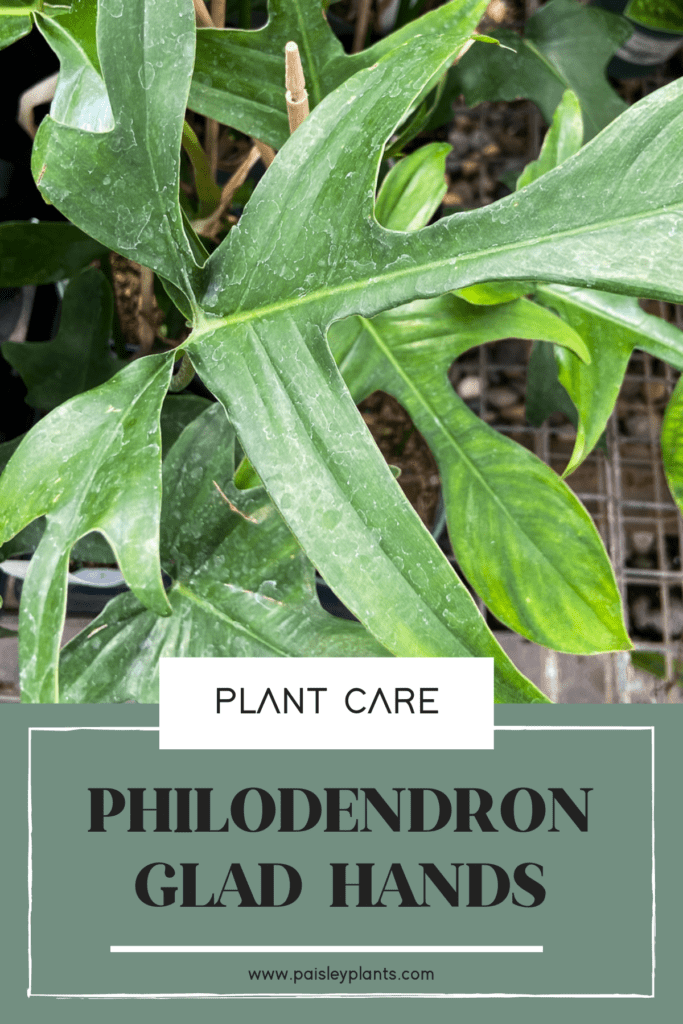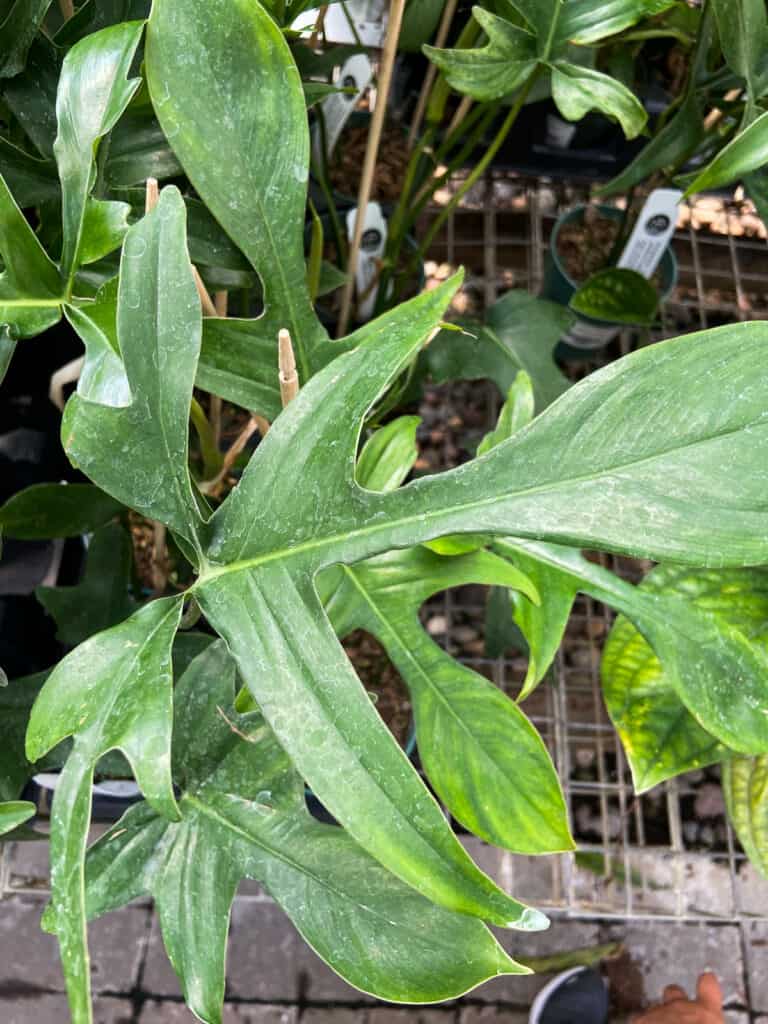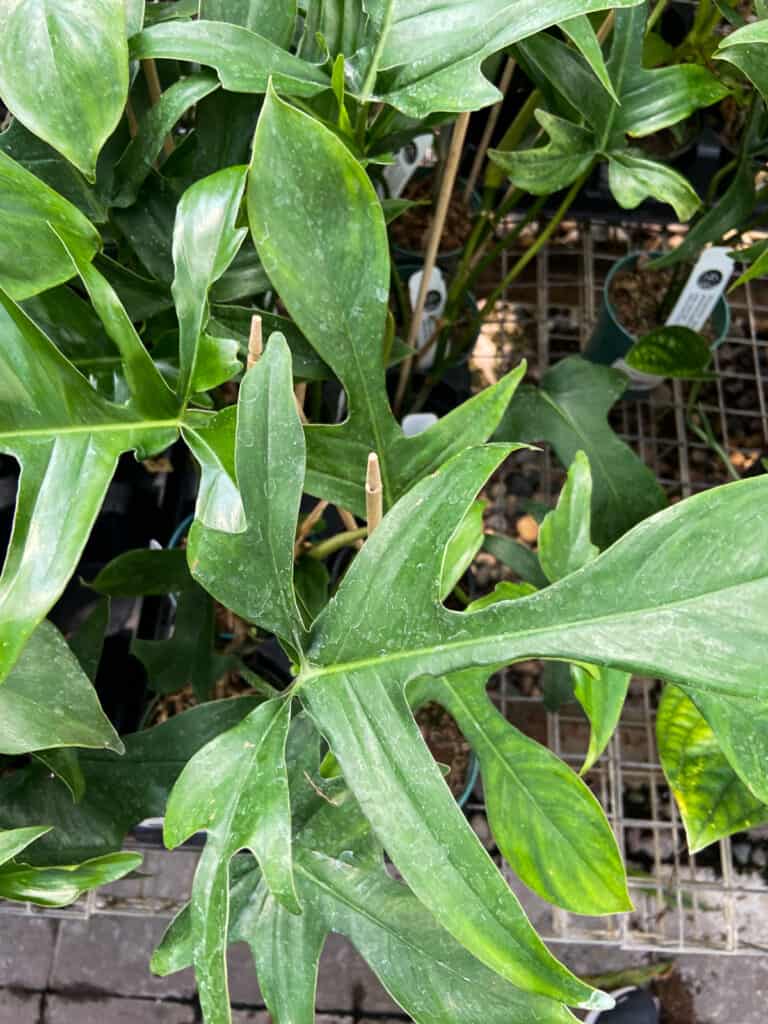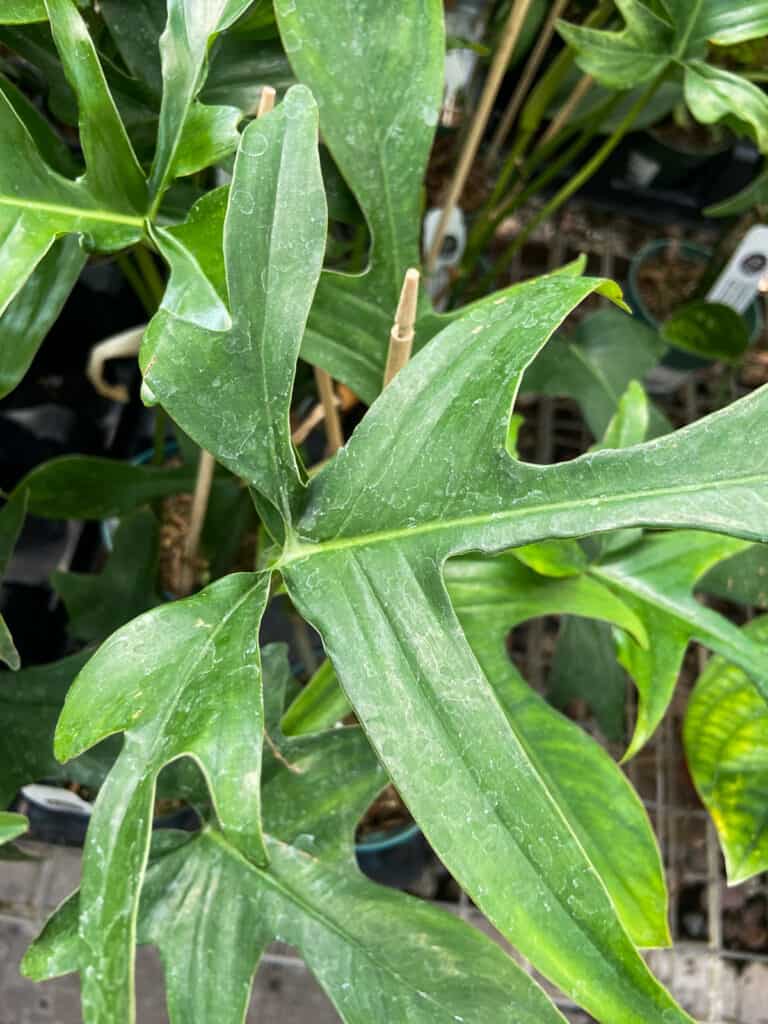The philodendron glad hands is a delightfully fun houseplant and you will be glad that you bought one! Read more for an in-depth look at how to care for this quirky philodendron.
Table of Contents
Philodendron Glad Hands Background
Native to South America, the philodendron glad hands is a variety of the philodendron pedatum. The main differentiation between the glad hands and the original pedatum is that the foliage of the glad hands is a little skinnier.
One of the common nicknames for the pedatum is the oak leaf philodendron. This is due to their unique leaf shape that roughly resembles that of an oak leaf. These green leaves grow to be very long and skinny.
When given the right care, the glad hands can grow to a staggering 4 to 8 feet tall indoors. In order to achieve a tall plant, it is best to train this plant up a pole so that it can stretch.
Just like all other philodendrons, these plants contains calcium oxalate crystals which are known to be toxic to both pets and human. Consumption of this plant can cause severe esophageal irritation.
If you’re looking for pet and kid friendly plants, check out these houseplants we can’t get enough of.
Philodendron Glad Hands Care

Sun & Light
Similar to most philodendrons, these plants grows best in bright, indirect sunlight. Please avoid exposing your philodendron to prolonged periods of direct sunlight, as this can cause scorching on the leaves.
The glad hands philodendron is also capable of surviving in partial light conditions, however this is not recommended if your goal is vigorous growth.
Soil Type
When select a soil for any type of philodendron there are three key aspects to keep in mind: it has to be well-draining, it has to have some moisture retention, and it needs to be mildly acidic. Many gardeners prefer an aroid potting mix when they care for a philodendron.
Aroid potting mixes could be made of many combination of materials, but the most common ones are made with garden soil, coco peat, sphagnum peat moss, charcoal, tree bark, perlite, etc.
Avoid mixes combine chunky material with moisture-retaining material to provide a soil that keeps roots aerated while also staying nourished.
In addition, they have a natural acidity so that you do not have to worry about maintaining the right pH balance.

Water
These house plants enjoy a soil that is consistently moist; though it is equally important to make sure that you are not overwhelming the plant with water. A good rule of thumb is to wait until the top layer of soil has dried up before you add any water your plant.
Fertilizer
This philodendron is a heavy feeder and will greatly appreciate a frequent fertilizing routine during its growing season. Select a water-soluble houseplant fertilizer with a balanced NPK ratio and apply this to your plant on a biweekly basis during the spring and summer.
It is advised to reduce your fertilizing routine to only once a month during the fall and winter. Too much fertilizing during this period is especially dangerous to your plant.
The philodendron enters a dormant period during the fall and winter where it does not need as much nutrients. The leftovers that goes unused can build up and acidify the soil to uninhabitable levels.
Temperature & Humidity

Being from the northern region of South America, the glad hands has a strong preference for warm, humid air conditions. Try your best to maintain a household temperature between 65° to 75° F.
Avoid allowing the temperature to go any lower than 60° by placing these plants away from any location near an air conditioning vent or a drafty window.
As for humidity, the ideal range for a healthy philodendron is around 50 to 60% humidity, which is more than attainable for most households.
Pruning & Maintenance
It is recommended to prune your philodendron as needed. Unlike some other philodendrons, the glad hands does not require a frequent pruning care regimen and can be done to the plant owner’s discretion.
However, it is always a good idea to trim any leaves that are dead or damaged in order to encourage new foliage growth.
Choosing a Container & Repotting
We cannot stress enough the importance of choosing a plant pot that has ample drainage holes. Adequate drainage in your pot is essential to keeping the soil at a comfortable level of moisture and prevent fungal diseases from breeding in your plants.
This particular philodendron has a moderate growth rate, and you can expect to change the pot roughly every 2 years. When resizing the pot, make sure to do so very gradually; moving to a pot size that is too big actually can have a counterproductive effect on your plant and send it into transplant shock.

How to Propagate a Glad Hands Philodendron Plant
These philodendrons can easily be propagated by stem cuttings.
Follow these steps to multiply your plant:
- Select a mature, healthy segment of your philodendron. This segment should be around 4 to 5 inches long and contain at least 3 leaves. Make a cut just below the leaf node.
- Cut the lower leaves from the bottom of the philodendron cutting in order to expose the nodes. There should still be 2-3 leaves remaining at the top of the cutting.
- Fill your small jar (or propagation station) with water and place the cut-end of the stem into the water. Place the jar in a location with bright, indirect light. Once a week, switch out the water.
- It takes roughly 4 weeks for roots to form from the cutting. Wait until the roots are at least 1 inch in length before transplanting into a pot.
- When transplanting, always make sure to use a pot with drainage holes and the appropriate soil for a philodendron. Keep the soil lightly moist for the next few weeks to avoid transplant shock.
Common Pests
Common household pests that might target your philodendron plants include aphids, spider mites, and mealybugs. These small sap-sucking pests latch onto your plants’ foliage and suck out the nutrients from it.
Finding pests on plants is never fun, but thankfully with a little care, there are simple, household solutions to curtail your pest problem.
Combine 1 liter of water with 1 teaspoon of dish soap in a spray bottle. Spritz the leaves on the plants for an easy homemade pest repellent. You may have to do a few rounds of this in order to fully eradicate your pest problem.
Many gardeners swear by neem oil for plants, and for their glad hands care, which is a natural pesticide that is sold at a reasonable price point. Similar with the dish soap solution, you must spray the plants a few times in order to control pests.
Common Diseases
Like with many other aroid plants, the glad hands variety is susceptible to root rot. Root rot is the combination of insufficient drainage combined with too much water.
Trapped water within the soil can harbor fungus which eventually breaks down the root system of the plant. This causes the foliage to pay the price of becoming discolored and wilted.
While root rot can be a scary thing to happen to plants, it is very treatable when handled early.
Follow these quick steps to remedy root rot:
- Remove your philodendron from its pot and inspect its root system. Healthy roots are firm and off-white, whereas rotted roots are mushy and black in color.
- Using a clean pair of shears, cut away at any roots that are rotted. Remove any signs of rot that you see.
- Repot your plant into a sterilized container that has plenty of drainage holes. Please ensure that you use fresh, well-draining soil. Keep the soil lightly moist for the first couple weeks to eliminate the risk of shock.
Where to Buy Philodendron Glad Hands
You can buy philodendron glad plants at these locations:
FAQ
Yellowing leaves are often a sign that the plants are not receiving enough water. Please keep in mind that these philodendrons likes a soil that is consistently moist, but not soggy. If you press your finger into the soil and notice that the soil is still dry down to your second knuckle, then it is a good time to rehydrate the plants. Give it a good, deep watering; make sure that the excess water flows out from the drainage holes.
Burnt, dry patches on the plants are often a sign that the plants is receiving too much direct sunlight. Remember that the philodendron plants prefers bright, indirect light. Being exposed to direct sun rays can cause severe damage to your plant’s leaves. In this situation, it is best to prune any leaves that suffered damage and place your plant in a location where the sun does not directly shine in.
Yes. Philodendron pedatum ‘Glad hands’ plants are a rare or hard-to-find houseplant.
In Conclusion
A philodendron glad hands will add a touch of uniqueness to your interior design, but without the commitment to owning a finicky plant. The glad hands is superbly easy to grow and care for.
If you have the opportunity to buy and care for this fun philodendron, do not hesitate to do so!
Need more Philodendrons in your life? Check out these other ultimate care guides!

